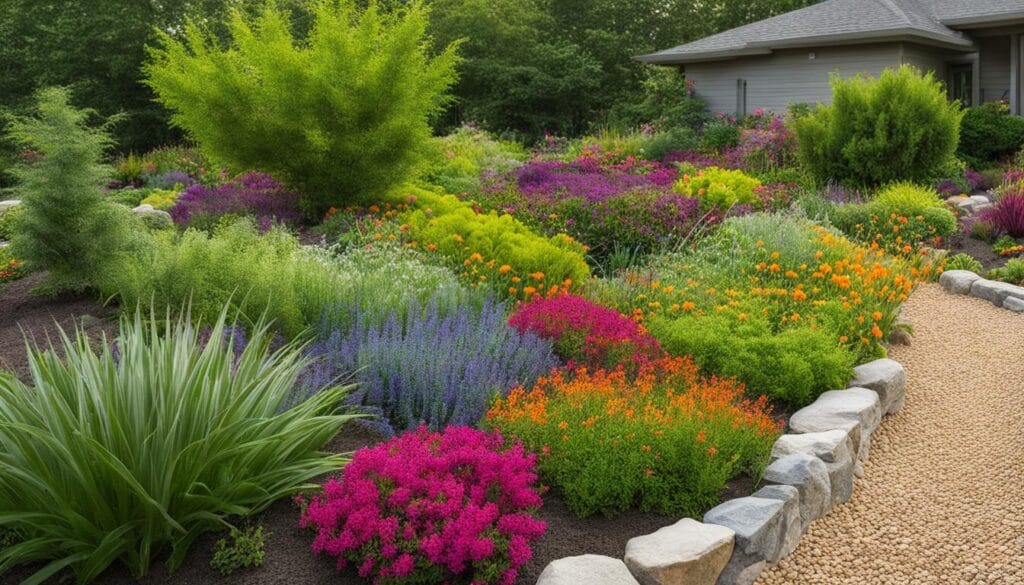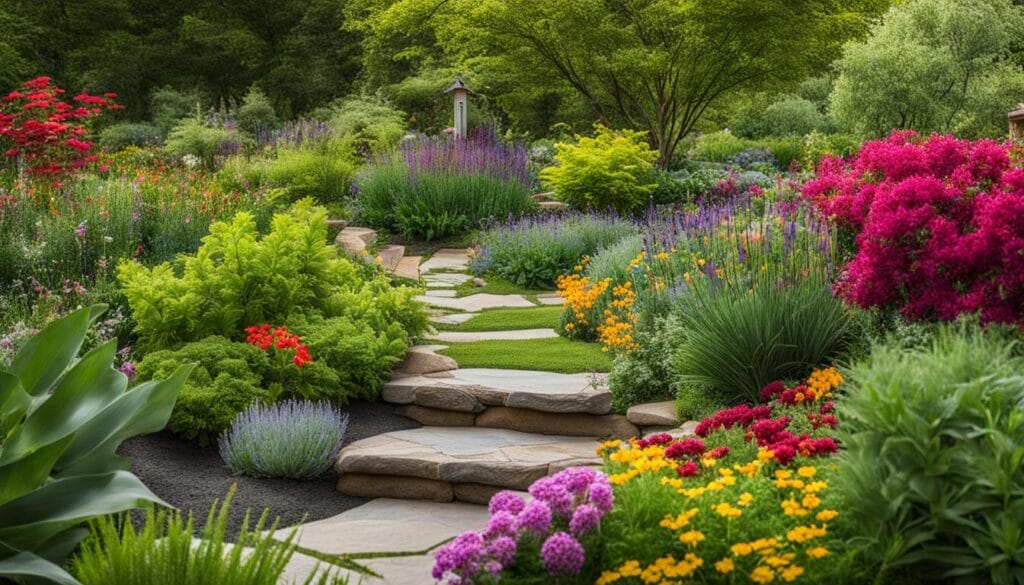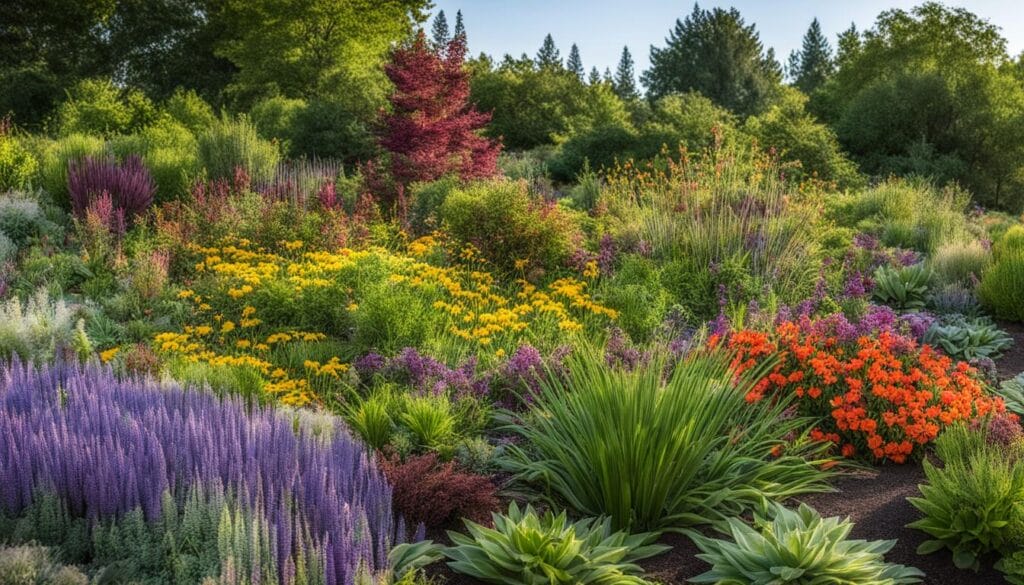Welcome to our guide on cost-effective native plant landscaping tips! If you’re looking for budget-friendly landscaping ideas that also promote sustainability, then incorporating native plants into your garden design is the way to go. Not only do native plants require less maintenance, but they also support biodiversity and help improve the environment. Let’s explore some low-cost native garden design suggestions that will transform your outdoor space into an affordable and sustainable oasis.
Key Takeaways:
- Native plants offer a cost-effective and low-maintenance solution for your garden.
- They support biodiversity, attracting pollinators and songbirds.
- Native plants with deeper roots help manage stormwater runoff.
- Adding colorful blooms to your native garden enhances its curb appeal.
- By selecting native plants that bloom at different times, you can create year-round interest.
Benefits of Native Plants in Land Development
Native plants play a crucial role in land development, offering numerous benefits that make them an ideal choice for sustainable landscaping. By incorporating native plants into land development projects, you can achieve cost-effective stormwater management and create low-maintenance landscapes that are both environmentally friendly and visually appealing.
Promoting Cost-Effective Stormwater Management
One of the key advantages of using native plants in land development is their ability to effectively manage stormwater. Native plants have deeper roots that help stabilize soil, reducing erosion and improving water absorption. This means less reliance on costly stormwater management facilities and increased overall cost savings. Furthermore, native plants can also qualify for financial credits for stormwater permits, providing additional incentives for their use.
Ensuring Low-Maintenance Landscaping
Native plants are renowned for their low-maintenance nature, making them a practical choice for land development projects. Unlike non-native and ornamental plants, native plants are well-adapted to the local soil and climate conditions. They generally require less watering, fertilization, and pesticide use, resulting in reduced maintenance costs and environmental impact. This makes them an excellent option for creating sustainable landscapes that require minimal upkeep while still offering aesthetic beauty.
By incorporating native plants in your land development projects, you can achieve cost-effective stormwater management and create landscapes that are not only sustainable but also visually appealing. The deep roots of native plants promote soil stability and water absorption, reducing erosion and the need for expensive stormwater management facilities. Additionally, native plants require less maintenance, saving you time and money on watering, fertilizing, and pest control. Embrace the benefits of native plants to maximize the ecological and financial potential of your land development endeavors.
| Benefits of Native Plants in Land Development | |
|---|---|
| Cost-Effective Stormwater Management | Native plants have deep roots that stabilize soil and reduce erosion, resulting in less reliance on costly stormwater management facilities. |
| Low-Maintenance Landscaping | Native plants are well-adapted to local conditions and require less watering, fertilization, and pesticide use, leading to reduced maintenance costs. |
Benefits of Native Plants in Land Development
- Cost-Effective Stormwater Management: Native plants have deep roots that stabilize soil and reduce erosion, resulting in less reliance on costly stormwater management facilities.
- Low-Maintenance Landscaping: Native plants are well-adapted to local conditions and require less watering, fertilization, and pesticide use, leading to reduced maintenance costs.
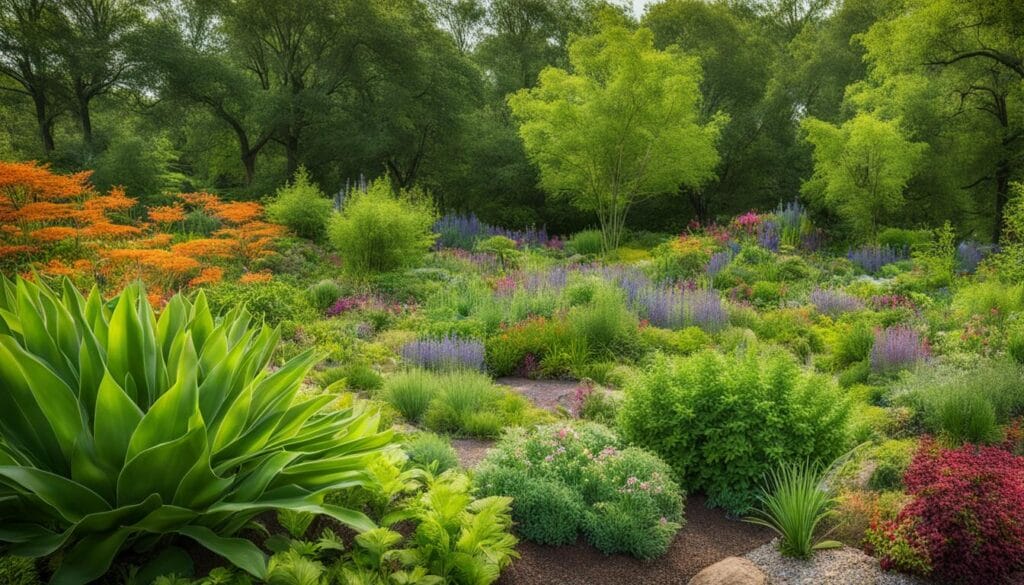
Native plants offer a multitude of benefits in land development, making them a valuable asset for creating sustainable and visually appealing landscapes. By embracing these cost-effective stormwater management solutions and low-maintenance landscaping options, you can enhance the ecological and financial viability of your land development projects.
Colorful Native Plants for Eye-Catching Curb Appeal
Adding colorful blooms to a native garden can enhance its curb appeal. Native plants come in a variety of colors and can be selected to create a vibrant and eye-catching display. It’s important to consider the bloom time of the plants to ensure year-round interest in the garden. There are many native plants available with colorful blooms, ranging from red columbine and blue penstemon to orange hawkweed and purple coneflower.
Incorporating these colorful native plants into your garden design can create a visually stunning landscape that stands out in your neighborhood. To make the most impact, consider grouping plants with complementary colors together. For example, pairing red columbine with purple coneflower can create a striking contrast. You can also use plant height to your advantage by placing taller plants with vibrant blooms at the back of flower beds and shorter plants with delicate blossoms towards the front.
To ensure a continuous display of colorful blooms throughout the year, choose native plants with different blooming seasons. Mix early spring bloomers like yellow wild indigo with summer-flowering options like orange butterfly weed and fall favorites like pink asters. By selecting a variety of plants, you can create a garden that stays vibrant from season to season.
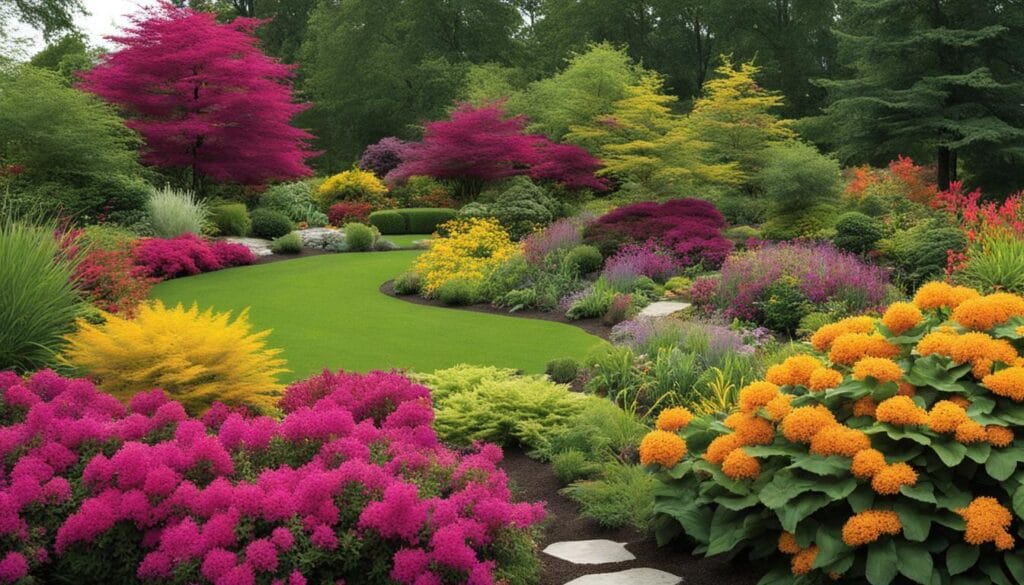
Table: Native Plants for Colorful Blooms
| Plant | Color | Bloom Time |
|---|---|---|
| Red Columbine | Red | Spring |
| Blue Penstemon | Blue | Spring |
| Orange Hawkweed | Orange | Summer |
| Purple Coneflower | Purple | Summer |
| Yellow Wild Indigo | Yellow | Spring |
| Orange Butterfly Weed | Orange | Summer |
| Pink Asters | Pink | Fall |
Creating a Year-Round Native Garden
A well-planned native garden can provide year-round interest. By selecting native plants that bloom at different times, you can ensure that your garden has something to enjoy throughout the seasons. Spring-blooming plants like red columbine and Jack-in-the-pulpit can add diversity to the landscape, while summer-blooming plants like butterfly milkweed and purple coneflower attract butterflies and birds. Fall-blooming asters and winterberry holly can provide visual interest during the colder months.
When planning your year-round native garden, consider the bloom time, color, and texture of the plants. Create a diverse palette of colors by incorporating plants with varying bloom times, such as early spring, late spring, and summer bloomers. This will ensure that your garden remains vibrant and visually appealing throughout the year.
Table: Native Plants for Year-Round Color
| Season | Native Plants |
|---|---|
| Spring | Red Columbine |
| Spring | Jack-in-the-pulpit |
| Summer | Butterfly Milkweed |
| Summer | Purple Coneflower |
| Fall | Asters |
| Winter | Winterberry Holly |
Don’t forget to include plants with attractive foliage that can provide visual interest even when they are not in bloom. Plants with colorful leaves or interesting textures can add depth and dimension to your garden, making it visually appealing throughout the year.
While it may be more challenging to find native plants that bloom in the winter, there are options available such as winterberry holly, witch hazel, and hellebores. These plants can add a splash of color to your garden during the colder months, ensuring that your native garden remains visually appealing year-round.
In summary, creating a year-round native garden requires careful selection of native plants that bloom at different times of the year. By incorporating early spring, late spring, summer, fall, and winter bloomers, you can ensure that your garden remains vibrant and visually appealing throughout all seasons. Don’t forget to include plants with attractive foliage for added interest. With proper planning and thoughtful plant selection, you can achieve a stunning year-round native garden that will bring beauty and joy to your outdoor space.
Design Tips for an Aesthetically Pleasing Native Garden
When it comes to creating an aesthetically pleasing native garden, it’s important to pay attention to the planting arrangement and overall visual appeal. By carefully considering the size and arrangement of your plants, you can create a stunning landscape that showcases the beauty of native species. Start by placing smaller plants towards the front of your garden bed and taller plants towards the back. This layering effect adds depth and ensures that all plants are visible, creating a visually appealing display.
In addition to the arrangement, grouping plants with similar characteristics can have a greater impact on the overall aesthetics of your garden. Consider grouping plants with similar colors or blooming times together. This creates a visually cohesive look and allows for a more impactful display of colors and textures. For example, you could create a grouping of purple coneflowers, black-eyed Susans, and goldenrod for a vibrant and eye-catching combination.
To further enhance the visual appeal of your native garden, pay attention to clean edges and borders. Use low-growing plants or groundcovers to create defined edges and pathways. This not only adds structure to your garden but also creates a neat and organized look. Consider using plants like creeping thyme or sedum for edging, as they are low-maintenance and provide a clean and polished appearance.
| Planting Arrangement Tips for an Aesthetically Pleasing Native Garden |
|---|
| Place smaller plants towards the front of the garden bed and taller plants towards the back to create a layered effect. |
| Group plants with similar characteristics, such as color or blooming time, for a visually cohesive look. |
| Use low-growing plants or groundcovers for clean edges and defined borders. |
Educating Others About Your Native Garden
Spreading awareness about your native garden is an important way to promote eco-friendly gardening practices and inspire others to follow suit. One effective method is to erect informative signs in your garden that highlight the benefits of native plants and explain their role in supporting pollinators and wildlife. These signs can also educate your neighbors about stormwater management and the financial credits associated with using native plants.
Another way to showcase your commitment to creating a wildlife-friendly habitat is by obtaining a wildlife habitat certification. This certification recognizes your efforts in providing food, water, cover, and places for wildlife to raise their young. By proudly displaying the certification in your garden or on a sign, you can inspire others to create their own wildlife habitats and contribute to the conservation of local biodiversity.
“Creating a native garden not only benefits the environment but also tells a story about our commitment to sustainability and the natural beauty of our landscape.”
“Educating others about your native garden is an opportunity to showcase the benefits of eco-friendly landscaping and inspire a sense of environmental stewardship. By sharing your knowledge and experiences, you can encourage others to embrace native plants, reduce their ecological footprint, and create a more sustainable future for our communities.”
– Green Thumb Magazine
By actively educating others about your native garden and its importance, you can help create a ripple effect of positive change. Through informative signs, wildlife habitat certification, and engaging conversations, you can spread awareness and inspire your community to embrace sustainable landscaping practices. Together, we can make a significant difference in preserving our environment for future generations.
Conclusion
By implementing cost-effective native plant garden tips, you can create an affordable and eco-friendly landscape that not only beautifies your outdoor space but also contributes to a sustainable environment. Native plants offer a range of benefits, attracting pollinators, reducing stormwater runoff, and requiring minimal maintenance.
With careful planning and design, you can create a vibrant and sustainable garden that adds value to your home while saving you money. Incorporate a variety of colorful native plants to enhance curb appeal and ensure year-round interest by selecting plants with different bloom times.
Consider the aesthetic aspect of your garden by arranging plants in a visually appealing manner, with smaller plants towards the front and taller ones towards the back. Grouping plants with similar characteristics will have a greater impact, and maintaining clean edges and borders will provide a tidy and organized look.
Spread awareness of your native garden by erecting informative signs, obtaining wildlife habitat certification, or showcasing your garden as a pollinator habitat. By sharing the benefits and purpose of your eco-friendly garden, you can inspire others to adopt sustainable gardening practices.
FAQ
Why should I use native plants in my landscaping?
Native plants are effective in increasing biodiversity, reducing stormwater, and improving the environment. They provide higher nutrient pollen sources and support a larger variety of pollinators and songbirds. Native plants also save on landscaping costs, as they do not require constant mowing and generally do not need fertilizers. Additionally, native plants with deeper roots can help manage stormwater runoff and provide financial credits for stormwater permits.
How do native plants benefit stormwater management?
Native plants have deeper roots that stabilize soil and absorb rainwater, which reduces the burden on stormwater management facilities. Using native plants in construction sites can also provide financial credits for stormwater permits. Additionally, native plants are low-maintenance and do not require constant mowing or the use of fertilizers, saving on landscaping costs.
Can native plants provide colorful blooms?
Yes, adding colorful blooms to a native garden can enhance its curb appeal. Native plants come in a variety of colors and can be selected to create a vibrant and eye-catching display. It’s important to consider the bloom time of the plants to ensure year-round interest in the garden. There are many native plants available with colorful blooms, ranging from red columbine and blue penstemon to orange hawkweed and purple coneflower.
How can I create a year-round native garden?
By selecting native plants that bloom at different times, you can ensure that your garden has something to enjoy throughout the seasons. Spring-blooming plants like red columbine and Jack-in-the-pulpit can add diversity to the landscape, while summer-blooming plants like butterfly milkweed and purple coneflower attract butterflies and birds. Fall-blooming asters and winterberry holly can provide visual interest during the colder months.
Are there any design tips for a native garden?
Designing an aesthetically pleasing native garden involves considering the size and arrangement of plants. By placing smaller plants towards the front and taller plants towards the back, you can create visual appeal and ensure that all plants are visible. Grouping plants with similar characteristics, such as color or blooming time, can also have a greater impact. Additionally, maintaining clean edges and borders by using low-growing plants for edging and defining pathways can contribute to a tidy and organized garden.
How can I educate others about my native garden?
If your native garden is unusual in your area, consider erecting an informative sign to educate your neighbors about its benefits. You can also work towards obtaining a wildlife habitat certification or install a sign indicating your garden as a pollinator habitat. By spreading awareness and explaining the purpose of your native garden, you can help others understand the importance of eco-friendly gardening practices.

